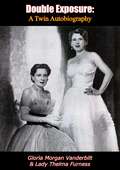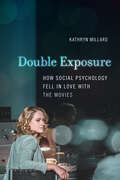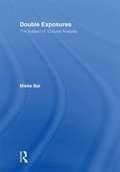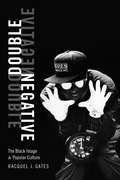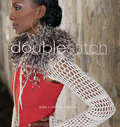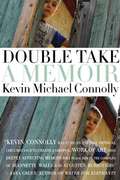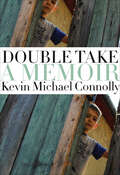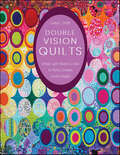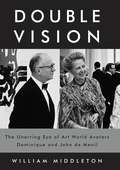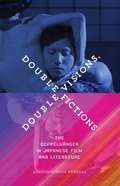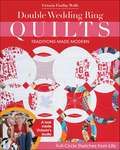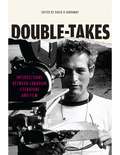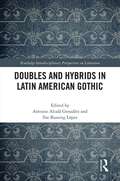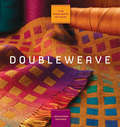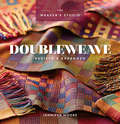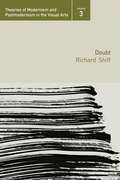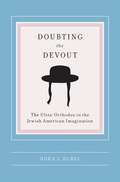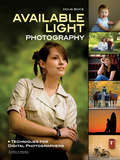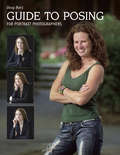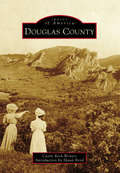- Table View
- List View
Double Exposure: A Twin Autobiography
by Gloria Morgan Vanderbilt Lady Thelma FurnessIn 1921 there burst upon the New York social scene the famous Morgan twins, Thelma and Gloria, whose names in the decade that followed came to spell glamour and excitement in that magic world of the “international set.” Two continents thrilled to Thelma Furness’s romances with Richard Bennett, Lord Furness, the Prince of Wales, Aly Khan, and Edmund Lowe. The whole world followed with bated breath the searing custody trial over young Gloria that pitted mother against daughter and shook the Vanderbilts and society. While much has been written from the outside about all of this, the two principals have never before disclosed the real truth behind the rumors and the headlines. And exciting as are their personal adventures and escapades, their story is also a portrait of an era.In every age there have been certain women who through a combination of beauty and personality have attracted the love and admiration of rich or famous men, and who seem to be the embodiments of the feminine charm of the period. The Edwardian era had its Lily Langtry, the Napoleonic its Josephine, the eighteenth century its Du Barry and its Lady Hamilton—and so on back to antiquity. In our time, among those women who have come close to fitting this role are Lady Furness and Gloria Vanderbilt.From childhood each had the elusive qualities that characterize the femme fatale. Both knew the love of many men, both suffered deeply, and now both have happily risen above the vicissitudes of their checkered careers and face the future with gallantry, humor, and without rancor or bitterness over the past. In this spirit, and with all sincerity, they have set down the story of their lives.In Double Exposure, we are given a matchless picture of life among the great—and the near-great—in the now-vanished world between the two wars. Above all, we come to know the minds and hearts and philosophy of life and love of two fascinating women, and something of the nature of fascination itself.
Double Exposure: How Social Psychology Fell in Love with the Movies
by Kathryn MillardDouble Exposure examines the role of film in shaping social psychology’s landmark postwar experiments. We are told that most of us will inflict electric shocks on a fellow citizen when ordered to do so. Act as a brutal prison guard when we put on a uniform. Walk on by when we see a stranger in need. But there is more to the story. Documentaries that investigators claimed as evidence were central to capturing the public imagination. Did they provide an alibi for twentieth century humanity? Examining the dramaturgy, staging and filming of these experiments, including Milgram's Obedience Experiments, the Stanford Prison Experiment and many more, Double Exposure recovers a new set of narratives.
Double Exposures: The Practice of Cultural Analysis
by Mieke BalA feminist literary theorist, specialist in Rembrandt, and a scholar with a knack for reading Old Testament stories, Mieke Bal weaves a tapestry of signs and meanings that enrich our senses. Her subject is the act of showing, the gesture of exposing to view. In a museum, for example, the object is on display, made visually available. "That's how it is," the display proclaims. But who says so?Bal's subjects are displays from the American Museum of Natural History, paintings by such figures as Courbet, Caravaggio, Artemisia Gentileschi, and Rembrandt, as well as works by twentieth-century artists, and such literary texts as Shakespeare's Rape of Lucrece.
Double Feature: Discovering Our Hidden Fantasies in Film
by Herbert H. Steina) What recent smash hit movie secretly depicted fear of the female breast? b) Name some recent films that were preoccupied with castration anxiety? c) Would you be surprised to know that reliving our childhood Oedipal fixations helps us to better understand adult-themed films? You'll find the answers to these and many similarly intriguing questions in DOUBLE FEATURE: DISCOVERING OUR HIDDEN FANTASIES IN FILM by Herbert Stein, M.D. Dr. Stein, a highly-respected Freudian psychiatrist and passionate moviegoer, literally puts our favorite films on the couch and shares his confidential findings with us. In a book that could become a cult classic, he lays bare the truth about unconscious and subconscious themes running through popular culture with fresh, jolting, and often moving insights into some of the most popular films ever made, including JURASSIC PARK, FIELD OF DREAMS, FORRST GUMP, THE SIXTH SENSE, and THE USUAL SUSPECTS. However perceptive we may think ourselves, this book reveals how we unconsciously respond to deeply-embedded archetypal themes in movies and enables us to re-experience films we love in a completely fresh way. Indeed, DOUBLE FEATURE makes our favorite films even more resonant and enables us to articulate even more deeply what it is we love about them.
Double Negative: The Black Image and Popular Culture
by Racquel J. GatesFrom the antics of Flavor Flav on Flavor of Love to the brazen behavior of the women on Love & Hip Hop, so-called negative images of African Americans are a recurrent mainstay of contemporary American media representations. <P><P>In Double Negative Racquel J. Gates examines the generative potential of such images, showing how some of the most disreputable representations of black people in popular media can strategically pose questions about blackness, black culture, and American society in ways that more respectable ones cannot. <P><P>Rather than falling back on claims that negative portrayals hinder black progress, Gates demonstrates how reality shows such as Basketball Wives, comedians like Katt Williams, and movies like Coming to America play on "negative" images to take up questions of assimilation and upward mobility, provide a respite from the demands of respectability, and explore subversive ideas. By using negativity as a framework to illustrate these texts' social and political work as they reverberate across black culture, Gates opens up new lines of inquiry for black cultural studies.
Double Rhythm: Writings About Painting (Artists & Art)
by Deborah Rosenthal Jean HélionJean Hélion, the French painter who died at eighty-three in 1987, brought together in his copious and essential writing on art the theoretical authority of the intellectual and the fundamental insights of the craftsman in his studio. His writing extended throughout the five decades or more of his career.Soon after the young painter's arrival in Paris from the provinces, he began a literary-art magazine; he wrote polemical articles as a leading avant-garde abstractionist; he wrote about the great tradition of figure painting while still painting abstractions; and he wrote journals, notes on studio practice, pieces about the role of the artist in society, and much more. His prolificacy is made more extraordinary because he wrote in two languages-having lived in the United States for some years, he wrote many of his articles in English for an American and British audience.This volume collects, for the first time, the diverse writings by Hélion that appeared in print originally in English, including "The Abstract Artist in Society," "Poussin, Seurat, and Double Rhythm," "Objects for a Painter," and many more. Double Rhythm is sure to become essential reading for art historians and painters.
Double Stitch: Designs for the Crochet Fashionista
by Erika Simmons Monika SimmonsMake a fashion statement with Double Stitch: Designs for the Crochet Fashionista, a collection of stylish, sexy, and modern crochet patterns for the fashion diva. Chicago-based crochet designers and twins Erika and Monika Simmons bring edge to the craft with twenty-five fashion-forward projects inspired by their retail design line using simple crochet techniques mixed with innovative construction, form-fitting designs, playful color combinations, and unique detailing.Even if you've never crocheted before, the simple techniques in Double Stitch-and the flirty, sassy designs-will have you crocheting in no time. Projects are divided into two main sections: "Out and About" features daytime crochet wear perfect for layering over T-shirts or wearing with jeans-taking you from the downtown coffeehouse to the beach with ease. Choose from projects that include a webbed halter dress, hooded poncho with matching leg warmers, a salsa belt, the remix T-shirt using a finished shirt with added crocheted sleeves, a tube-style apron top, plus much more. "Paint the Town" features evening looks with fun detailing, open weave crochet, and glamorous accessories. Projects include a gothic shawl, feather choker with matching cocktail bag, peek-a-boo full-length dress, slinky tailored shrug, corset with satin ribbon tie, shrunken jacket, plus much more. At the back of the book are all of the basic crochet techniques you need to create each project featured. The projects all have a hip, bohemian, urban vibe that can be dressed up or down based on the styling.Whether you live in a big city or just want to look like you do, the young designers behind Double Stitch show how easy it is to make crochet fashionably modern, flirtatious, and fun.
Double Take: A Memoir
by Kevin Michael ConnollyKevin Michael Connolly is a twenty-three-year old man who has seen the world in a way most of us never will. Whether swarmed by Japanese tourists at Epcot Center as a child or holding court at the X Games on his mono-ski, Kevin Connolly has been an object of curiosity since the day he was born without legs. Growing up in rural Montana, he was raised like any other kid (except, that is, for his father's MacGyver-like contraptions such as the "butt bucket." As a college student, Kevin trawled to seventeen countries on his skateboard, including Bosnia, China, Ukraine, and Japan. In an attempt to capture the stares of others, he took more than 33,000 photographs of people staring at him. In this dazzling memoir, Connolly casts the lens inward to explore how we view ourselves and what it is to truly see another person. We also get to know his quirky and unflappable parents and his girlfriend. From the home of his family in Helena, Montana, to the streets of Tokyo and Kuala Lumpur, Kevin's remarkable journey will change the way you look at others, and the way you see yourself.
Double Take: A Memoir
by Kevin Michael Connolly“Kevin Connolly has used an unusual physical circumstance to create a gripping work of art. This deeply affecting memoir will place him in the company of Jeanette Walls and Augusten Burroughs.” — Sara Gruen, author of Water for Elephants“Charming … Connolly recounts growing up a scrappy Montana kid—one who happened to be born without legs... [Double Take] makes for an empowering read.” — PeopleAs featured on 20/20, NPR, and in the Washington Post: Kevin Connolly is a young man born without legs who travels the world—by skateboard, with his camera—on his “Rolling Exhibition,” snapping pictures of peoples’ reactions to him… and finds out along the way what it truly means to be human.
Double Vision Quilts: Simply Layer Shapes & Color for Richly Complex Curved Designs
by Louisa L. SmithFool the eye with dynamic quilts that are easy to sew Learn how to turn squares and rectangles into circles and ovals with no curved piecing—it’s easy! Use innovative layering, playful patterns, and delightful color choices to create 11 mind-bending quilt projects that’ll have you seeing double. The best-selling author of Strips ‘n Curves shares three simple construction methods. With something for every type of quilter, the endless possibilities of this collection will inspire you to see quilting in a whole new light. • No curved piecing! Add three easy techniques to your repertoire for no-stress circles and ovals • 11 opulent quilts with dazzling primary and secondary designs • Learn layering, texture, color, and pattern with the best-selling author of Strips ‘n Curves
Double Vision: The Unerring Eye of Art World Avatars Dominique and John de Menil
by William MiddletonThe first and definitive biography of the celebrated collectors Dominique and John de Menil, who became one of the greatest cultural forces of the twentieth century through groundbreaking exhibits of art, artistic scholarship, the creation of innovative galleries and museums, and work with civil rights.Dominique and John de Menil created an oasis of culture in their Philip Johnson-designed house with everyone from Marlene Dietrich and René Magritte to Andy Warhol and Jasper Johns. In Houston, they built the Menil Collection, the Rothko Chapel, the Byzantine Fresco Chapel, the Cy Twombly Gallery, and underwrote the Contemporary Arts Museum. Now, with unprecedented access to family archives, William Middleton has written a sweeping biography of this unique couple. From their ancestors in Normandy and Alsace, to their own early years in France, and their travels in South America before settling in Houston. We see them introduced to the artists in Europe and America whose works they would collect, and we see how, by the 1960s, their collection had grown to include 17,000 paintings, sculptures, drawings, photographs, rare books, and decorative objects. And here is, as well, a vivid behind-the-scenes look at the art world of the twentieth century and the enormous influence the de Menils wielded through what they collected and built and through the causes they believed in.
Double Visions, Double Fictions: The Doppelgänger in Japanese Film and Literature
by Baryon Tensor PosadasA fresh take on the dopplegänger and its place in Japanese film and literature—past and present Since its earliest known use in German Romanticism in the late 1700s, the word Doppelgänger (double-walker) can be found throughout a vast array of literature, culture, and media. This motif of doubling can also be seen traversing historical and cultural boundaries. Double Visions, Double Fictions analyzes the myriad manifestations of the doppelgänger in Japanese literary and cinematic texts at two historical junctures: the interwar period of the 1920s and 1930s and the present day. According to author Baryon Tensor Posadas, the doppelgänger marks the intersection of the historical impact of psychoanalytic theory, the genre of detective fiction in Japan, early Japanese cinema, and the cultural production of Japanese colonialism. He examines the doppelgänger&’s appearance in the works of Edogawa Rampo, Tanizaki Jun&’ichiro, and Akutagawa Ryunosuke, as well as the films of Tsukamoto Shin&’ya and Kurosawa Kiyoshi, not only as a recurrent motif but also as a critical practice of concepts. Following these explorations, Posadas asks: What were the social, political, and material conditions that mobilized the desire for the doppelgänger? And how does the dopplegänger capture social transformations taking place at these historical moments?Double Visions, Double Fictions ultimately reveals how the doppelgänger motif provides a fascinating new backdrop for understanding the enmeshment of past and present.
Double Wedding Ring Quilts: Traditions Made Modern
by Victoria Findlay WolfeA timeless design, reinvented for modern quilters Get ready for new adventures in conventional piecing with celebrated quilter Victoria Findlay Wolfe. Create stunning Double Wedding Ring quilts with breathtaking innovations on the classic pattern. With full-size patterns for 10 quilts, the book will teach you the Double Wedding Ring basics. After you’ve mastered curved foundation piecing, try your hand at Victoria’s unique fabric slashing and “Made-Fabric” methods—it’s easier than you think! You’ll feel liberated as you improvise on her designs, with full instruction for some quilts and others that invite your creative discovery. Read the stories that inspired each of Victoria’s designs, and then take inspiration from the artist at work in her studio, with photography of her creative process and 3 bonus quilts to jumpstart your own art. 13 modern Double Wedding Ring quilts and their stories Peek inside the studio of award-winning quilter Victoria Findlay Wolfe Full-size patterns! Learn paper piecing, fabric slashing, and tips to create “Made-Fabric” Modern traditional designs with fresh color choices From the award-winning author of 15 Minutes of Play—Improvisational Quilts
Double Your Money in Antiques in 60 Days: Turn Your Collecting Hobby into a Profitable Weekend Sideline or Full-Time Business
by George GrotzPopular antiques expert George Grotz reveals how to make real money in the antiques trade--must reading for every collector, auction-goer, and flea-market fanatic.
Double-Takes: Intersections between Canadian Literature and Film (Reappraisals: Canadian Writers)
by David R. JarrawayOver the past forty years, Canadian literature has found its way to the silver screen with increasing regularity. Beginning with the adaptation of Margaret Laurence’s A Jest of God to the Hollywood film Rachel, Rachel in 1966, Canadian writing would appear to have found a doubly successful life for itself at the movies: from the critically acclaimed Kamouraska and The Apprenticeship of Duddy Kravitz in the 1970s through to the award-winning Love and Human Remains and The English Patient in the 1990s. With the more recent notoriety surrounding the Oscar-nominated Away from Her, and the screen appearances of The Stone Angel and Fugitive Pieces, this seems like an appropriate time for a collection of essays to reflect on the intersection between literary publication in Canada, and its various screen transformations. This volume discusses and debates several double-edged issues: the extent to which the literary artefact extends its artfulness to the film artefact, the degree to which literary communities stand to gain (or lose) in contact with film communities, and perhaps most of all, the measure by which a viable relation between fiction and film can be said to exist in Canada, and where that double-life precisely manifests itself, if at all. - This book is published in English.
Doubles and Hybrids in Latin American Gothic (Routledge Interdisciplinary Perspectives on Literature)
by Antonio Alcalá González Ilse Bussing LópezDoubles and Hybrids in Latin American Gothic focuses on a recurrent motif that is fundamental in the Gothic—the double. This volume explores how this ancient notion acquires tremendous force in a region, Latin America, which is itself defined by duplicity (indigenous/European, autochthonous religions/Catholic). Despite this duplicity and at the same time because of it, this region has also generated "mestizaje," or forms resulting from racial mixing and hybridity. This collection, then, aims to contribute to the current discussion about the Gothic in Latin America by examining the doubles and hybrid forms that result from the violent yet culturally fertile process of colonization that took place in the area.
Doubleweave (The\weaver's Studio Ser.)
by Jennifer MooreDefy Your Loom's Limits!The conventional use for a shaft loom is to weave one layer of flat fabric, no wider than the loom. Doubleweave blows that convention out of the water. Master weaver Jennifer Moore takes a fresh and logical look at this most intriguing of weave structures while exploring its myriad possibilities. Inside you'll learn how to: Weave a fabric twice, thrice, or four times the width of your loom - with no seam Weave a fabric with intersecting layers Change the tie-up to get many structures on one warp Weave stitched, quilted, and piqué fabricsMake color magic with doubleweave blocks Pick up an infinity of patterns in a variety of structures Weave pockets, a seamless tube, many seamless tubes, a tube within a tube And so much more! With Doubleweave, you'll learn to set up your loom efficiently, to manage your shuttles and layer changes, and to finish your work effectively. Best of all, you'll learn to think in a new way about how doubleweave works on as many shafts as you have so you can apply it in fresh and creative ways. You will be a master of the magic of doubleweave.
Doubleweave Revised & Expanded (The Weaver's Studio)
by Jennifer MooreConventional shaft loom weaving constricts the weaver into making only a single layer of fabric that is no wider than the loom. Increase your loom's capabilities with Doubleweave Revised & Expanded! In this comprehensive guide to doubleweave, master-weaver Jennifer Moore revisits the tips and techniques to weaving in multiple layers. Doubleweave Revised & Expanded is filled with new information about doubleweaving and more including: • More doubleweave technique samples for both 4 and 8-shaft looms, including more overshot patterns. • Expanded information on how to weave fabric twice, thrice or even four-times the width of your loom, with no seam. • Beautiful doubleweave project patterns for the home and more! Expand the abilities of your loom with Doubleweave Revised & Expanded!
Doubt (Theories of Modernism and Postmodernism in the Visual Arts)
by Richard ShiffIn an age where art history’s questions are now expected to receive answers, Richard Shiff presents a challenging alternative. In this essential new addition to James Elkins’s series Theories of Modernism and Postmodernism in the Visual Arts, Richard Shiff embraces doubt as a critical tool and asks how particular histories of art have come to be. Shiff’s turn to doubt is not a retreat to relativism, but rather an insistence on clear thinking about art. In particular, Shiff takes issue with the style of self-referential art writing seemingly 'licensed' by Roland Barthes. With an introduction by Rosie Bennett, Doubt is a study of the tension between practicing art and practicing criticism.
Doubting the Devout: The Ultra-Orthodox in the Jewish American Imagination (Religion and American Culture)
by Nora L RubelBefore 1985, depictions of ultra-Orthodox Jews in popular American culture were rare, and if they did appear, in films such as Fiddler on the Roof or within the novels of Chaim Potok, they evoked a nostalgic vision of Old World tradition. Yet the ordination of women into positions of religious leadership and other controversial issues have sparked an increasingly visible and voluble culture war between America's ultra-Orthodox and non-Orthodox Jews, one that has found a particularly creative voice in literature, media, and film.Unpacking the work of Allegra Goodman, Tova Mirvis, Pearl Abraham, Erich Segal, Anne Roiphe, and others, as well as television shows and films such as A Price Above Rubies, Nora L. Rubel investigates the choices non-haredi Jews have made as they represent the character and characters of ultra-Orthodox Jews. In these artistic and aesthetic acts, Rubel recasts the war over gender and family and the anxieties over acculturation, Americanization, and continuity. More than just a study of Jewishness and Jewish self-consciousness, Doubting the Devout will speak to any reader who has struggled to balance religion, family, and culture.
Doug Box's Available Light Photography
by Doug BoxCovering every aspect of creating portraits in available light, acclaimed professional photographer Doug Box provides tips for finding great natural light, practical approaches for optimizing exposure, and techniques for posing subjects for the most flattering effects. For those situations when "perfect" available light can't be found, readers are shown how to modify ambient light to suit their purposes-or give it a bump in intensity with a little pop of flash. Additional topics touched upon include proper lens selection, calculating exposure, managing ambient light both indoors and out, shooting at night, and more. A discussion of applying the many techniques to nature and wildlife, travel, and sports photography rounds out this all-encompassing guide to working with available light.
Doug Box's Available Light Photography
by Doug BoxCovering every aspect of creating portraits in available light, acclaimed professional photographer Doug Box provides tips for finding great natural light, practical approaches for optimizing exposure, and techniques for posing subjects for the most flattering effects. For those situations when "perfect" available light can't be found, readers are shown how to modify ambient light to suit their purposes-or give it a bump in intensity with a little pop of flash. Additional topics touched upon include proper lens selection, calculating exposure, managing ambient light both indoors and out, shooting at night, and more. A discussion of applying the many techniques to nature and wildlife, travel, and sports photography rounds out this all-encompassing guide to working with available light.
Doug Box's Guide to Posing for Portrait Photographers
by Douglas Allen BoxOften overshadowed by complicated lighting techniques or advanced postproduction tips, this resource seeks to remind the professional photographer of the fundamental importance of a subject's pose. Conveniently designed in two-page spreads-a striking portrait on one side, a comprehensive how-to of the strategies used on the other-this reference includes countless techniques for studio sessions as well as outdoor and location shoots, with individuals or groups, male or female clients, and in sitting, standing, or lying poses. With advice from a well-known and respected professional, it covers all the basics, showing how to emphasize a client's assets and downplay perceived flaws, how to create a cohesive, engaging group photo, how to use natural elements on location to enhance an image, and how to ensure that the result flatters the subject and adds the essential professional polish to an image.
Douglas A-4 Skyhawk: Attack & Close-Support Fighter Bomber
by Jim WinchesterA detailed look at the combat aircraft designed by the legendary Edward H. Heinemann with one role in mind: tactical nuclear delivery. The Skyhawk first entered service with the US Navy almost 50 years ago. It is still in service with various US units and remains the backbone of many of the air forces of those countries to which it has been exported. &“Heinemann&’s Hot Rod&” was never called upon for its original purpose—nuclear delivery from aircraft carriers—but its well-designed airframe proved adaptable to many other uses. This is an in-depth look at the design, production, evolution, operation and performance of the aircraft. It will also include first-hand accounts of flying the Skyhawk in action.
Douglas County: A Photographic Journey (Images of America)
by Castle Rock Writers Shaun BoydCastle Rock Writers bring readers a collection of vintage images and sketches of Douglas County from approximately 1861 to 1950, covering the settling of towns such as Parker and Sedalia and rural areas like Cherry Valley and Daniel�s Park. Early homesteaders, adventurers, and prospectors journeyed west following the 900-plus miles along the Cherokee Trail, seeking the wealth of gold or needing the curative air of Colorado. On the long and arduous trip, travelers stopped at the Twenty Mile House in Parker or the Pretty Woman Ranch on the First Territorial Road. They needed to clean off the dust and dirt and enjoy a nourishing meal before the final push to Denver and beyond. Some simply stayed. They homesteaded ranches, staked out mines, and built small towns in the rolling plains, mesas, forested hills, and mountains that make up the 843 square miles of Douglas County. In the first half of the 20th century, the region grew into cohesive communities, where families thrived through ingenuity and hard work. Neighbors supported neighbors.
